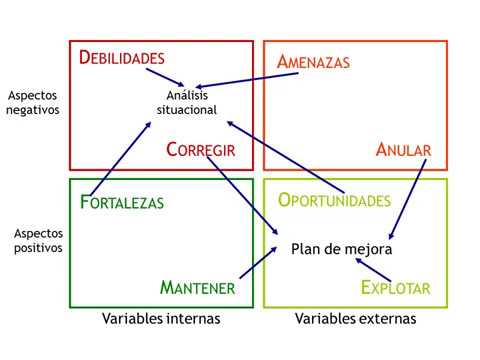Analisis dafo y came
swot analysis
For many, the SWOT analysis is the natural continuation of what is known as SWOT analysis, for others it is an integral and essential part of it. Regardless of who is “right”, what is clear is that both analyses are closely linked, so the first thing we are going to do is to describe briefly what a SWOT or SWOT analysis consists of and in this description we will see where the SWOT Analysis is located and its importance.
The SWOT analysis or matrix, also known in English-speaking countries as SWOT, is a strategic tool that allows an analysis of the current situation of a person, project, company or institution based on the analysis of its internal factors (Strengths and Weaknesses) and external factors (Opportunities and Threats) with the aim of facilitating the best decision making for that situation.
Once the above questions have been answered, we will be clear about our current situation in order to be able to face present and future challenges. We will therefore be ready to select a strategy to achieve the objectives defined at the beginning of the SWOT analysis.
swot analysis in english
The SWOT analysis is the tool that will allow you to define your company’s strategic plan, once you have created your SWOT matrix. It identifies which factors you can correct, confront, maintain and exploit, to make your business develop in the right direction.
The SWOT analysis is an indispensable tool if you want to make the most of the conclusions drawn from the SWOT matrix. Very often, a business situation analysis is carried out, certain conclusions are drawn, but no strategy is implemented.
As we saw in our article on SWOT analysis, it is necessary that, once you have a snapshot of the state of your company or business, you implement the appropriate strategies to ensure its continuity and growth.
Offensive strategies -also known as attack and market positioning strategies- focus on exploiting the strengths of your business and taking advantage of market opportunities.
Their reduced structure and lack of processes give them great flexibility to take advantage of new opportunities in the market, which allows them to position themselves quickly.
comentarios
En el mundo de la empresa, encontramos dos términos el DAFO y el CAME. El DAFO es Debilidades, Amenazas, Fortalezas y Oportunidades. A lo que se contrapone el CAME, que es Corregir, Adaptar, Mantener y Explorar. Así que nos quedamos sólo con dos del DAFO (amenazas y oportunidades), y con sus dos contrapartidas del CAME (adaptar y explorar).
Mi problema no es con el vocabulario y el significado en sí, sino con encontrar la traducción adecuada para CAME. Obviamente DAFO es un análisis DAFO y por lo tanto, me imagino que CAME es otra idea levantada y traducida de la cultura empresarial estadounidense con un equivalente muy específico. Gracias por su ayuda.
analysis came example
Any company that aspires to stand out in its market niche and stand out from the competition needs to know precisely the reality of the sector. More importantly, it needs to know itself in depth. That is why it is important to know in detail what SWOT and CAME analysis consists of.
The SWOT analysis, also known as SWOT analysis, is a tool used by companies, institutions or projects to know their internal situation (strengths and weaknesses) and external situation (threats and opportunities). The objective of this is to know the real situation in order to obtain an advantage over competitors.
The external analysis is carried out by analyzing opportunities and threats. To do this, it is necessary to be clear about the environmental facts or events with which the organization is related. It can be complemented with a PEST or PESTEL analysis.
These are a series of positive and favorable factors for the organization. It is important to know what they are in order to take advantage of them and provide positive factors to the brand. In this section several factors must be taken into account:

